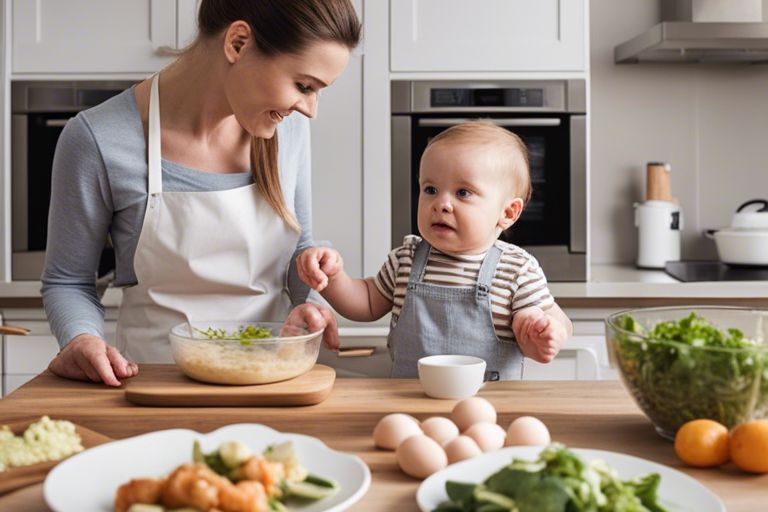tips, tricks and guides for parenthood
Overwhelmed with the idea of starting your baby on solid foods? With baby-led weaning, where babies feed themselves rather than being spoon-fed purees, busy parents can find a practical and efficient way to introduce their little ones to solid foods. However, there are some important Do's and Don'ts to keep in mind to ensure a safe and successful experience. From choosing the right foods to avoiding potential choking hazards, this blog post will guide you through the crucial steps of baby-led weaning for busy parents.

If you're considering starting baby-led weaning, it's important to prepare both mentally and practically. Read up on the concept, familiarise yourself with which foods are suitable, and ensure your baby is showing signs of readiness. Clear your schedule for mealtimes, as this approach requires time and patience. Get ready for messy mealtimes, and most importantly, be prepared to relax and let your little one explore and enjoy food at their own pace.
Getting the right equipment can make the baby-led weaning journey much smoother. Invest in a good highchair with a secure harness to keep your baby safe while they explore different foods. Easy-to-clean bibs and floor mats will be your lifesavers during messy mealtimes. Baby-friendly cutlery and plates are important for little hands learning to feed themselves. Stock up on a variety of suitable finger foods to offer your baby a range of tastes and textures.
Some What Is Baby-Led Weaning? Benefits, Tips, and First Foods parents may find baby-led weaning overwhelming, but with the right approach, it can be a fantastic way to introduce solids to your baby.
The key to success in baby-led weaning is to offer a wide range of foods to your little one. This will help them develop a taste for different textures and flavours, promoting a varied and balanced diet from an early age.
Weaning your baby onto solid foods can be daunting, but ensuring safe food sizes and shapes is crucial. Cut food into manageable pieces to prevent choking hazards. Always supervise your baby during mealtimes and avoid foods that could pose a choking risk.
Understanding the importance of safe food sizes and shapes is necessary to prevent choking incidents and ensure your baby's safety while they explore new tastes and textures.
For a safe baby-led weaning journey, it is vital to avoid common choking hazards. One key tip is to avoid giving whole nuts, grapes, or chunks of raw vegetables that could potentially cause choking. Instead, opt for foods that are cut into manageable sizes or cooked until soft to reduce the risk of choking.
On your baby-led weaning adventure, remember to steer clear of unnecessary stress. Introducing solids can be a messy and chaotic process, but it's important to stay calm and patient. Focus on the fun and learning experience rather than worrying about the mess or your baby's eating speed. Keep mealtimes positive and enjoyable for both you and your little one.
Another important point to remember is to avoid rushing your baby's progress. Every baby develops at their own pace, so it's crucial not to compare them to others. Some days they may eat more than others, and that's completely normal. Offer a variety of healthy foods and let your baby explore and enjoy the process at their own speed.
Despite your best efforts, messes and fussiness are inevitable during the baby-led weaning journey. Setbacks in the form of food flinging and picky eating are common, but remember, it's all part of the learning process. Stay patient and stay positive - involve your little one in the clean-up and offer a variety of nutritious foods to encourage exploration.
Setbacks may also arise when it comes to balancing nutrition and independence. It's imperative to offer a variety of foods to ensure your baby gets the nutrients they need, even if they prefer certain foods over others. Note, baby-led weaning is about giving your child the independence to choose what and how much to eat, but as a parent, you play a crucial role in ensuring they receive a balanced diet.
Another key aspect to consider is monitoring your baby's development and growth. Regularly consulting with a healthcare professional can help ensure that your baby is meeting their nutritional needs while exploring a range of foods during their weaning journey. It's all about finding that balance between providing nutritious options and fostering independence in your little one.
With these considerations in mind, busy parents can successfully navigate the world of baby-led weaning. Do focus on providing a variety of nutritious foods, including family meals, and allow your baby to explore different textures and flavours at their own pace. Don't rush the process, force-feed, or introduce choking hazards. Remember to always supervise your baby during meals and trust their hunger cues. By following these do's and don'ts, parents can enjoy watching their little ones grow and develop healthy eating habits while minimising stress and maximising quality time together.
A: Baby-led weaning is a method of introducing solid foods to babies that allows them to feed themselves from the very start, promoting self-feeding and exploring different textures and tastes.
A: Baby-led weaning is recommended to start around 6 months of age, when babies show signs of readiness such as being able to sit up unassisted and grab objects.
A: Baby-led weaning can save time for busy parents as there is no need to prepare separate purees, and it encourages babies to join family meals, making mealtimes more enjoyable and inclusive.
A: Some common do's of baby-led weaning include offering a variety of foods, allowing your baby to explore textures with their hands, and ensuring they are always seated upright while eating.
A: Some don'ts of baby-led weaning include never leaving your baby unattended while they eat, avoiding foods that are choking hazards, and not rushing or forcing your baby to eat if they're not interested.